《学前教育专业英语》第一章
- 格式:pptx
- 大小:5.66 MB
- 文档页数:58
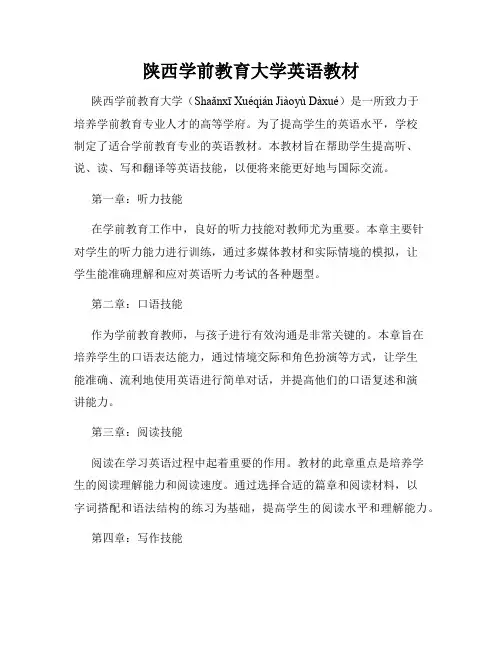
陕西学前教育大学英语教材陕西学前教育大学(Shaǎnxī Xuéqián Jiàoyù Dàxué)是一所致力于培养学前教育专业人才的高等学府。
为了提高学生的英语水平,学校制定了适合学前教育专业的英语教材。
本教材旨在帮助学生提高听、说、读、写和翻译等英语技能,以便将来能更好地与国际交流。
第一章:听力技能在学前教育工作中,良好的听力技能对教师尤为重要。
本章主要针对学生的听力能力进行训练,通过多媒体教材和实际情境的模拟,让学生能准确理解和应对英语听力考试的各种题型。
第二章:口语技能作为学前教育教师,与孩子进行有效沟通是非常关键的。
本章旨在培养学生的口语表达能力,通过情境交际和角色扮演等方式,让学生能准确、流利地使用英语进行简单对话,并提高他们的口语复述和演讲能力。
第三章:阅读技能阅读在学习英语过程中起着重要的作用。
教材的此章重点是培养学生的阅读理解能力和阅读速度。
通过选择合适的篇章和阅读材料,以字词搭配和语法结构的练习为基础,提高学生的阅读水平和理解能力。
第四章:写作技能写作是学习英语的关键技能之一。
本章将帮助学生提升写作能力,包括写作结构、语法规则和词汇的灵活运用。
通过写作练习,学生将能够自信地进行表达,从而更好地应对学前教育工作中的英语书写要求。
第五章:翻译技能学前教育专业的学生将来可能需要进行英语翻译工作,因此翻译技能对他们来说是必不可少的。
本章将培养学生的英译中和中译英能力,通过翻译实例的练习,让学生掌握翻译理论和常用技巧,提高他们的翻译水平。
总结陕西学前教育大学英语教材的编写旨在提高学生的英语能力,以满足学前教育专业的需求。
通过听、说、读、写和翻译等技能的全面培养,学生将能更好地与国际接轨,为将来的职业发展打下坚实的基础。
本教材将不断更新和完善,以适应教育领域的最新变化和学生的需求。
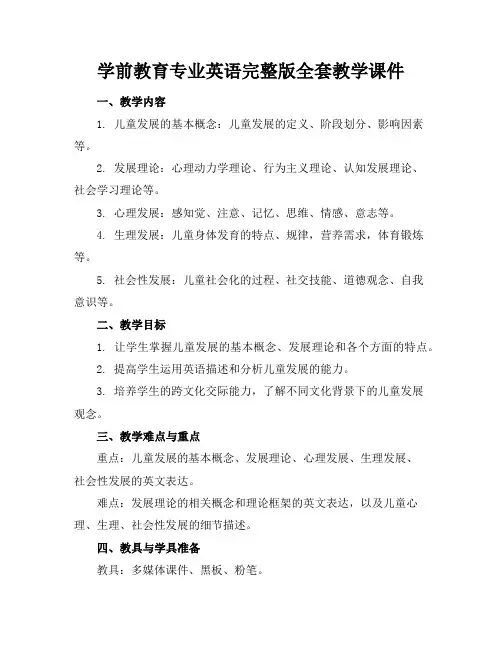
学前教育专业英语完整版全套教学课件一、教学内容1. 儿童发展的基本概念:儿童发展的定义、阶段划分、影响因素等。
2. 发展理论:心理动力学理论、行为主义理论、认知发展理论、社会学习理论等。
3. 心理发展:感知觉、注意、记忆、思维、情感、意志等。
4. 生理发展:儿童身体发育的特点、规律,营养需求,体育锻炼等。
5. 社会性发展:儿童社会化的过程、社交技能、道德观念、自我意识等。
二、教学目标1. 让学生掌握儿童发展的基本概念、发展理论和各个方面的特点。
2. 提高学生运用英语描述和分析儿童发展的能力。
3. 培养学生的跨文化交际能力,了解不同文化背景下的儿童发展观念。
三、教学难点与重点重点:儿童发展的基本概念、发展理论、心理发展、生理发展、社会性发展的英文表达。
难点:发展理论的相关概念和理论框架的英文表达,以及儿童心理、生理、社会性发展的细节描述。
四、教具与学具准备教具:多媒体课件、黑板、粉笔。
学具:教材、笔记本、文具。
五、教学过程1. 导入:通过展示儿童发展的图片,引导学生思考儿童发展的重要性,激发学习兴趣。
2. 讲解:分别讲解儿童发展的基本概念、发展理论、心理发展、生理发展、社会性发展的英文表达,并结合实例进行说明。
3. 讨论:分组讨论儿童发展的各个方面,让学生运用所学知识进行分析。
4. 练习:布置随堂练习,让学生运用所学知识进行答题。
6. 拓展:引导学生关注不同文化背景下的儿童发展观念,提高跨文化交际能力。
六、板书设计板书内容:儿童发展基本概念、发展理论、心理发展、生理发展、社会性发展。
板书结构: + 关键词 + 简要解释 + 实例。
七、作业设计1. 作业题目:请用英语写一篇关于儿童发展的短文,包括儿童发展的基本概念、发展理论、心理发展、生理发展、社会性发展等方面的内容。
2. 答案:Children's development refers to the process of physical, cognitive, emotional, and social changes that occur inchildren as they grow from infancy to adulthood. It isinfluenced genetic factors, environmental factors, and individual experiences.There are several theories of child development that explain how children grow and develop. The psychodynamic theory proposed Sigmund Freud emphasizes the role of unconscious desires and conflicts in shaping a child's personality. The behaviorist theory, represented B.F. Skinner, focuses on the role of environmental stimuli and reinforcement in learning and behavior. The cognitive development theory, developed Jean Piaget, explains how children's thinking and understanding develop through stages. The social learning theory, proposed Albert Bandura, emphasizes the importance of observational learning and modeling in the development of social behavior.八、课后反思及拓展延伸本节课通过讲解和讨论,使学生对儿童发展的基本概念、发展理论和各个方面有了更深入的了解。
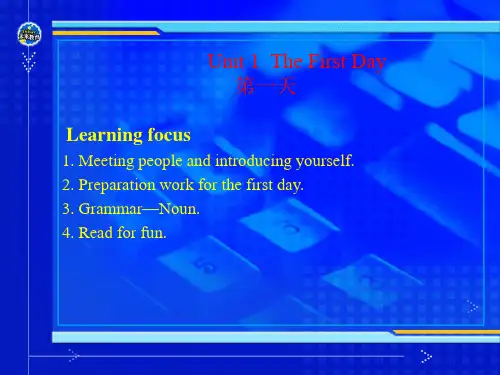
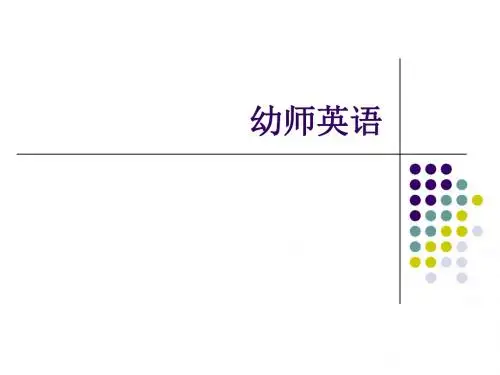
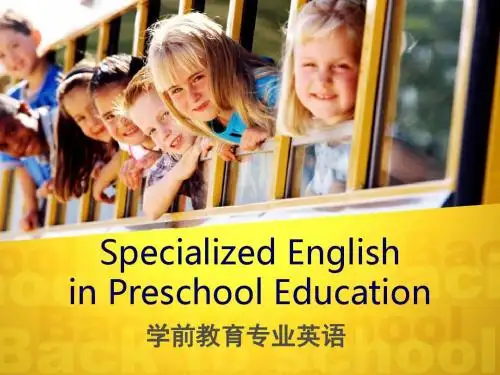
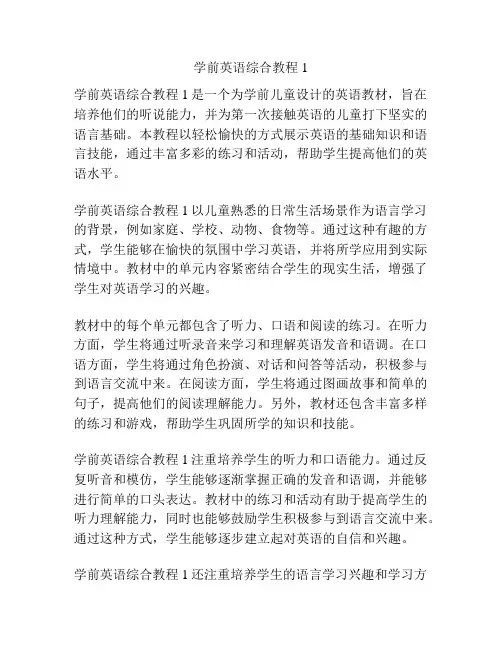
学前英语综合教程1学前英语综合教程1是一个为学前儿童设计的英语教材,旨在培养他们的听说能力,并为第一次接触英语的儿童打下坚实的语言基础。
本教程以轻松愉快的方式展示英语的基础知识和语言技能,通过丰富多彩的练习和活动,帮助学生提高他们的英语水平。
学前英语综合教程1以儿童熟悉的日常生活场景作为语言学习的背景,例如家庭、学校、动物、食物等。
通过这种有趣的方式,学生能够在愉快的氛围中学习英语,并将所学应用到实际情境中。
教材中的单元内容紧密结合学生的现实生活,增强了学生对英语学习的兴趣。
教材中的每个单元都包含了听力、口语和阅读的练习。
在听力方面,学生将通过听录音来学习和理解英语发音和语调。
在口语方面,学生将通过角色扮演、对话和问答等活动,积极参与到语言交流中来。
在阅读方面,学生将通过图画故事和简单的句子,提高他们的阅读理解能力。
另外,教材还包含丰富多样的练习和游戏,帮助学生巩固所学的知识和技能。
学前英语综合教程1注重培养学生的听力和口语能力。
通过反复听音和模仿,学生能够逐渐掌握正确的发音和语调,并能够进行简单的口头表达。
教材中的练习和活动有助于提高学生的听力理解能力,同时也能够鼓励学生积极参与到语言交流中来。
通过这种方式,学生能够逐步建立起对英语的自信和兴趣。
学前英语综合教程1还注重培养学生的语言学习兴趣和学习方法。
教材中的内容简单易懂,适合学前儿童的认知水平。
同时,教材中的活动和游戏也充满了趣味性,能够吸引学生的注意力,激发他们学习英语的兴趣。
通过这种有趣的学习方式,学生能够更好地理解和掌握所学的知识。
总之,学前英语综合教程1是一个适合学前儿童的英语教材,通过有趣的内容和多样的练习,帮助学生提高他们的英语水平。
教材注重培养学生的听说能力,激发他们学习英语的兴趣。
通过这种愉快的学习方式,学生能够在轻松的氛围中学习英语,并为将来的英语学习打下坚实的基础。
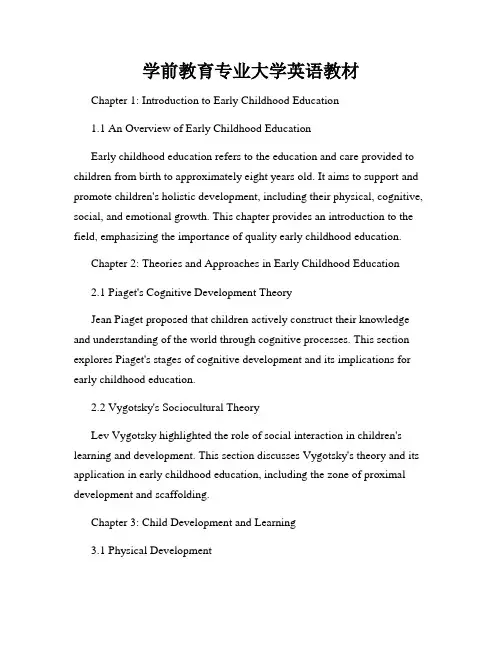
学前教育专业大学英语教材Chapter 1: Introduction to Early Childhood Education1.1 An Overview of Early Childhood EducationEarly childhood education refers to the education and care provided to children from birth to approximately eight years old. It aims to support and promote children's holistic development, including their physical, cognitive, social, and emotional growth. This chapter provides an introduction to the field, emphasizing the importance of quality early childhood education.Chapter 2: Theories and Approaches in Early Childhood Education2.1 Piaget's Cognitive Development TheoryJean Piaget proposed that children actively construct their knowledge and understanding of the world through cognitive processes. This section explores Piaget's stages of cognitive development and its implications for early childhood education.2.2 Vygotsky's Sociocultural TheoryLev Vygotsky highlighted the role of social interaction in children's learning and development. This section discusses Vygotsky's theory and its application in early childhood education, including the zone of proximal development and scaffolding.Chapter 3: Child Development and Learning3.1 Physical DevelopmentThis section focuses on children's physical development during the early years, including motor skills, coordination, and sensory development. It discusses the importance of providing a conducive environment for children to explore and develop their physical abilities.3.2 Cognitive DevelopmentChildren's cognitive development refers to the development of thinking, problem-solving, and memory skills. This section explores various aspects of cognitive development and suggests effective teaching strategies to enhance children's cognitive growth.3.3 Social and Emotional DevelopmentThe social and emotional development of children plays a crucial role in their overall well-being. This section examines the milestones and factors influencing social and emotional development, emphasizing the importance of creating a supportive and nurturing environment.Chapter 4: Curriculum and Instruction in Early Childhood Education4.1 Curriculum ModelsDifferent curriculum models, such as Montessori, Reggio Emilia, and High Scope, have emerged in early childhood education. This section explores these models, highlighting their principles, goals, and approaches to curriculum planning.4.2 Play-Based LearningPlay is an essential aspect of early childhood education. This section discusses the importance of play-based learning and offers practicalsuggestions for incorporating play into the curriculum to promote children's holistic development.Chapter 5: Assessment and Evaluation in Early Childhood Education5.1 Purpose of AssessmentAssessment in early childhood education serves multiple purposes, including monitoring children's progress, identifying individual needs, and informing instructional decisions. This section explores different assessment methods and their appropriate use in the early years.5.2 Observational AssessmentObservational assessment involves systematically observing and documenting children's behaviors, interactions, and learning experiences. This section provides guidance on conducting effective observational assessments and using the information gathered to inform teaching and learning.Chapter 6: Family and Community Engagement6.1 Importance of Family-Teacher PartnershipsFamily involvement and collaboration between teachers and families are essential for supporting children's learning and development. This section discusses effective strategies for building positive partnerships with families and engaging the community in early childhood education.Chapter 7: Inclusive Practices in Early Childhood Education7.1 Inclusion and DiversityInclusive practices aim to provide equitable learning opportunities for all children, regardless of their abilities or backgrounds. This section explores the principles of inclusive education and provides strategies for creating inclusive early childhood classrooms.Chapter 8: Professional Ethics and Development in Early Childhood Education8.1 Ethical Standards for Early Childhood EducatorsEarly childhood educators are responsible for upholding ethical standards in their professional practice. This section discusses the ethical dilemmas educators may encounter and provides guidance on ethical decision-making.8.2 Professional Development in Early Childhood EducationContinuing professional development is crucial for early childhood educators to enhance their knowledge, skills, and pedagogical practices. This section highlights the importance of ongoing professional development and explores various avenues for educators to engage in professional learning.ConclusionThe study of early childhood education is vital for individuals aspiring to work with young children. This textbook provides a comprehensive overview of the field, covering various aspects such as theories, child development, curriculum, assessment, family engagement, inclusive practices, and professional ethics. By studying this material, future educators will be equipped with the necessary knowledge and skills to provide high-quality education and care to young children.。
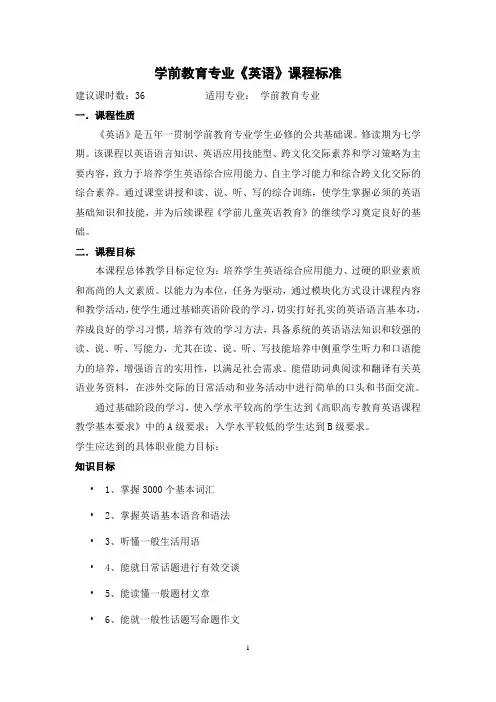
学前教育专业《英语》课程标准建议课时数:36 适用专业:学前教育专业一.课程性质《英语》是五年一贯制学前教育专业学生必修的公共基础课。
修读期为七学期。
该课程以英语语言知识、英语应用技能型、跨文化交际素养和学习策略为主要内容,致力于培养学生英语综合应用能力、自主学习能力和综合跨文化交际的综合素养。
通过课堂讲授和读、说、听、写的综合训练,使学生掌握必须的英语基础知识和技能,并为后续课程《学前儿童英语教育》的继续学习奠定良好的基础。
二.课程目标本课程总体教学目标定位为:培养学生英语综合应用能力、过硬的职业素质和高尚的人文素质。
以能力为本位,任务为驱动,通过模块化方式设计课程内容和教学活动,使学生通过基础英语阶段的学习,切实打好扎实的英语语言基本功,养成良好的学习习惯,培养有效的学习方法,具备系统的英语语法知识和较强的读、说、听、写能力,尤其在读、说、听、写技能培养中侧重学生听力和口语能力的培养,增强语言的实用性,以满足社会需求。
能借助词典阅读和翻译有关英语业务资料,在涉外交际的日常活动和业务活动中进行简单的口头和书面交流。
通过基础阶段的学习,使入学水平较高的学生达到《高职高专教育英语课程教学基本要求》中的A级要求;入学水平较低的学生达到B级要求。
学生应达到的具体职业能力目标:知识目标•1、掌握3000个基本词汇•2、掌握英语基本语音和语法•3、听懂一般生活用语•4、能就日常话题进行有效交谈•5、能读懂一般题材文章•6、能就一般性话题写命题作文•7、能借助字典翻译一般性文章•8.了解西方文化知识、风俗习惯。
•9.掌握一般文体和应用文体的语篇知识。
能力目标•1、掌握500个和行业相关词汇•2、在职场环境熟练运用英语语法•3、听懂与未来职业相关的对话和陈述•4、能就与未来职业相关的话题进行有效交谈•5、读懂与未来职业相关的文章•6、能模拟套写与未来职业相关的应用文•7、能借助字典翻译和未来职业相关的业务性素质目标1、良好的道德素质2、过硬的职业素质3、高尚的人文素质三、课程内容和要求第一册序号教学单元知识要求建议课时1 Family ●掌握家庭成员介绍的基本表达方式●掌握如何对家庭成员进行更细致地介绍●掌握家庭成员介绍的写法62 Holidays ●掌握西方文化中的节日●了解中西方节日文化的差异●掌握节日贺卡的写法6第二册第三册四、实施建议(一)教材选用与编写1、教材使用建议教材选用与编写应体现通识教育导向、有利于学生的发展及课程体系的完整性原则,第1至6学期选用《英语教程》(编写)。
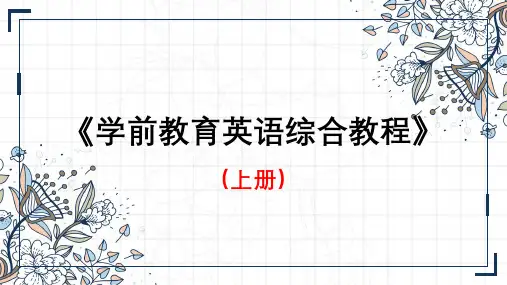
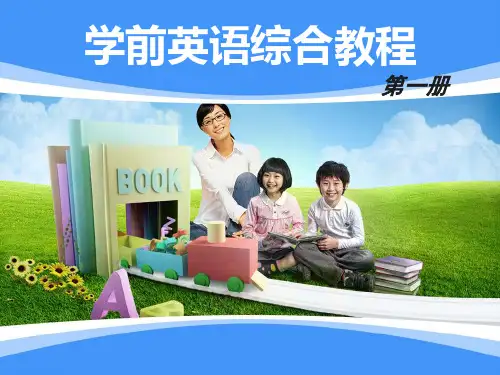
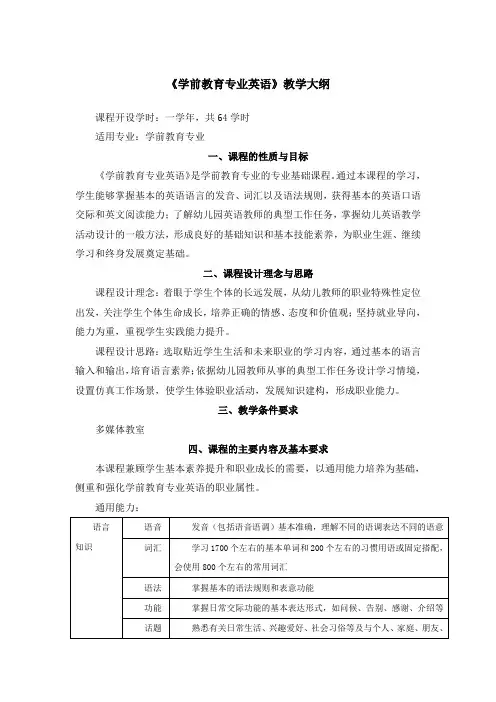
《学前教育专业英语》教学大纲课程开设学时:一学年,共64学时适用专业:学前教育专业一、课程的性质与目标《学前教育专业英语》是学前教育专业的专业基础课程。
通过本课程的学习,学生能够掌握基本的英语语言的发音、词汇以及语法规则,获得基本的英语口语交际和英文阅读能力;了解幼儿园英语教师的典型工作任务,掌握幼儿英语教学活动设计的一般方法,形成良好的基础知识和基本技能素养,为职业生涯、继续学习和终身发展奠定基础。
二、课程设计理念与思路课程设计理念:着眼于学生个体的长远发展,从幼儿教师的职业特殊性定位出发,关注学生个体生命成长,培养正确的情感、态度和价值观;坚持就业导向,能力为重,重视学生实践能力提升。
课程设计思路:选取贴近学生生活和未来职业的学习内容,通过基本的语言输入和输出,培育语言素养;依据幼儿园教师从事的典型工作任务设计学习情境,设置仿真工作场景,使学生体验职业活动,发展知识建构,形成职业能力。
三、教学条件要求多媒体教室四、课程的主要内容及基本要求本课程兼顾学生基本素养提升和职业成长的需要,以通用能力培养为基础,侧重和强化学前教育专业英语的职业属性。
通用能力:职业能力:课程结构及内容:五、考核模式与成绩评定办法评价主体:采用学生自我评价、小组评价和教师评价结合的评价机制。
学生完成任务后作自我评价,小组成员间协同评价,教师根据学生任务完成情况进行评定,多方面客观地评价学生的学习与表现。
考核内容:全方位考核学生的知识、能力与素质。
课程考核实行百分制,采用平时成绩(20%)+任务成绩(30%)+期末成绩(50%)的成绩结构,平时成绩主要考核学生的日常出勤、自主学习能力、沟通合作能力、创新能力与学习态度;任务成绩主要考核学生课下任务完成情况,对照各项任务的评价标准,根据学生完成各个任务的情况进行评定;期末成绩采用闭卷考核的方式,主要考核学生对书面知识的掌握情况,根据试卷评分标准评定成绩。